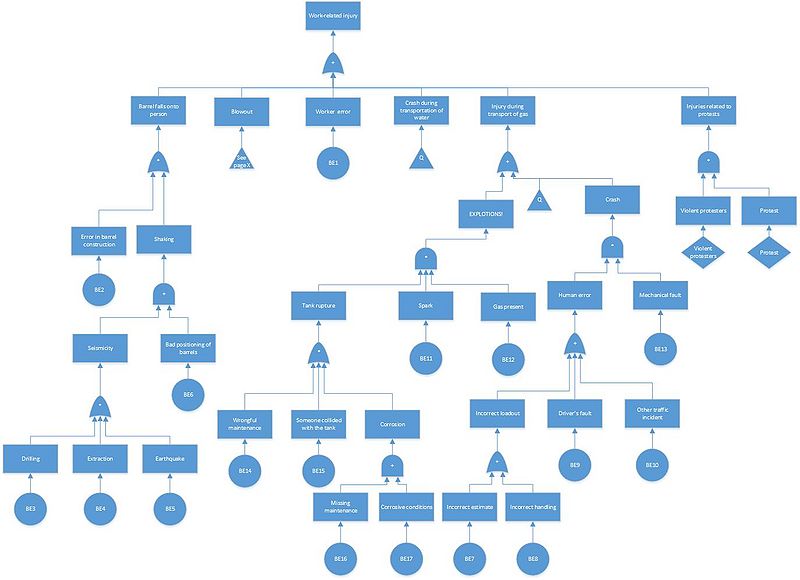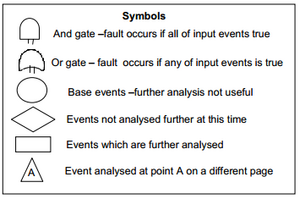Fault tree analysis
| Line 15: | Line 15: | ||
FTA is a top down analysis where one identifies the undesired state and places it as the top event, then goes through all intermediary events and draws their connection to the top event through various gates, and finally, once all intermediary events have been discovered and the base events are reached, these are added as the root of the trees. | FTA is a top down analysis where one identifies the undesired state and places it as the top event, then goes through all intermediary events and draws their connection to the top event through various gates, and finally, once all intermediary events have been discovered and the base events are reached, these are added as the root of the trees. | ||
| − | [[File:Fault_Tree_example.jpg| | + | [[File:Fault_Tree_example.jpg|800px|center|Figure 1: A fault tree]] |
==History== | ==History== | ||
Revision as of 16:46, 20 September 2015
Fault Tree Analysis
Fault tree analysis (Hereby noted as FTA) is a technique primarily used within Risk analysis. It provides a visual representation of an undesired event, as well as the dependencies of said event, thereby allowing one to identify and analyse what factors can contribute to this event, also called base events. Finally, it allows one to calculate the probabilities of the top event. Unfortunately, the FTA has certain limitations, as with all models, and as such, they are not sufficient alone to analyse all risks in a project. Nevertheless, FTA is a very powerful tool in managing risks, and allows for good visualizations of events and allows a displined, highly systematic, flexible approach to analysing these risks.
This article will consist of four sections:
- Big Idea: This section will explain the concept of FTA, as well as show an example of a fully developed Fault tree. It will also briefly explain the history of FTA.
- Applications: This section will explain how to use FTA.
- Limitations: This section will explore the limitations of FTA.
- Annotated Bibliography: This section will provide key references that can be read for further elaboration on FTA.
Contents |
Big Idea
Concept
FTA is a top down analysis where one identifies the undesired state and places it as the top event, then goes through all intermediary events and draws their connection to the top event through various gates, and finally, once all intermediary events have been discovered and the base events are reached, these are added as the root of the trees.
History
Fault tree diagrams were originally invented in 1962 by the Bell Telephone Laboratories. They did this on behalf of the US Air Force in connection with the Minuteman ICBM launch control system. It was very succesful, and were subsequently adopted by the Boing Company, then the US army, then US government and, in today's world, it is used widely in System Safety and Reliability Engineering, as well as many other major fields of engineering, and can be applicated to almost any project that needs to know the effect of various events and how they connect with other events.
Applications
A fault tree consists of 6 different symbols. Of these, two are gates and 4 are events, as seen by figure 2.
- And gate: An And gate has two or more inputs and one output. If all inputs are true, then the output will be true as well, thus causing the event above the gate, but if just one event is false, the event above will not happen
- Or gate: Or gates are mostly the same as And gates - where they differ is that only one input has to be true to cause the above event, and all inputs has to be false to not cause the above event
- Base event: An event that is not analysed further, meaning that it could either not be broken down into further detail, or doing so would be counter-productive. In the example of figure 1, base events....
- Event that is not analysed further: This group of events are usually events that lack data, meaning that further analysis is meaningless.
- Event that is analysed further: Intermediary events that are analysed further.
- Event analysed on a different page: Used as a link to make huge Fault trees into smaller trees, allowing for a better overlook.
Limitations
There are several limitations in the FTA model. Below follows a brief overview, followed by an elaboration on each subject.
- Uncertainties in the probabilities of the top event
- The whole picture is not discovered
- FTAs are a static model
- Fault trees only possess binary states
- Human error is not easily included
- FTAs do not easily enable domino effects
Uncertainties in the top event: Due to the fact that the probability of the top event is calculated from the probability of the base event and the interconnected events, if the probability of the base events are not known accurately, it will cause uncertainty in the rest of the system.
The whole picture is not discovered: Sometimes, causal events are not discovered, or intermediary events are missing, thus creating a fault tree that does not cover the entire system. In this case, it prevents probability analysis until the events are discovered.
FTAs are a static model: Since FTAs are static models, time is not taken into account in the model
Fault trees only possess binary states: Fault trees only possess binary states, and as such, partial failures cannot be represented in these trees
Human error is not easily included: Since human error varies greatly, and since Fault trees only posses binary states, one either has to include a lot of different events to compensate for possible human failure, which clouds up the diagrams, or simplify it with a simple "Human error" state, which does not show the complete picture. As such, showing human error in fault trees is not easily done.
FTAs do not easily enable domino effects:
Annotated Bibliography
Risk Management - Risk Assesment Techniques, Dansk Standard, 2010 [[1]], visited the 13/9, 2015
Sample Code snips
This is a list
- List1
- List2
- List2
This is a picture
This is big, italian and underlined * You can choose to work on one of two types of articles: *
Here's some links
Articles Fall Term 2015 User's Guide Configuration settings list MediaWiki FAQ MediaWiki release mailing list Help Content
Aaanndd some references


